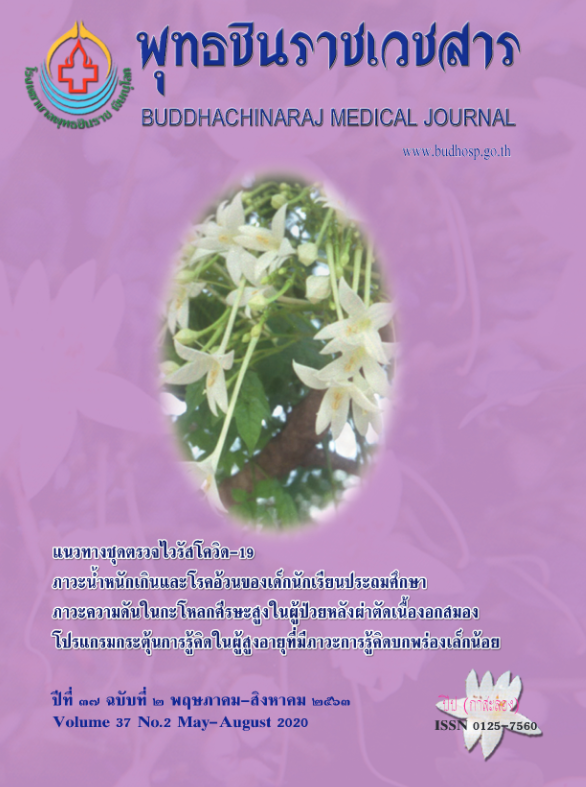การพัฒนารูปแบบการป้องกันการติดเชื้อในกระแสเลือดที่เกี่ยวข้องกับการใส่คาสายสวน หลอดเลือดดำส่วนกลาง
การป้องกันการติดเชื้อในกระแสเลือดที่เกี่ยวข้องกับการใส่คาสายสวนหลอดเลือดดำส่วนกลาง
คำสำคัญ:
การติดเชื้อในกระแสเลือดที่เกี่ยวข้องกับการใส่คาสายสวนหลอดเลือดดำส่วนกลาง, การเช็ด บริเวณข้อต่อของสายสวนหลอดเลือดดำส่วนกลาง, เทคนิคดัน หยุด ดัน หยุดบทคัดย่อ
การใส่คาสายสวนหลอดเลือดดำส่วนกลางมีภาวะแทรกซ้อนที่สำคัญคือการติดเชื้อในกระแสเลือด การวิจัยเชิงปฏิบัติการนี้มีวัตถุประสงค์เพื่อพัฒนารูปแบบการดูแลผู้ป่วยที่ใส่สายสวนหลอดเลือดดำส่วนกลางและประเมินอัตราการติดเชื้อระหว่างเดือน มกราคม-ธันวาคม พ.ศ. 2561 ในโรงพยาบาลพุทธชินราช พิษณุโลก โดยระยะที่ 1 ศึกษาสถานการณ์การดูแลผู้ป่วยที่ใส่สายสวน หลอดเลือดดำส่วนกลางด้วยการสนทนากลุ่มกับพยาบาลและแพทย์ 21 คน และทบทวนรายงานผู้ป่วย ระยะที่ 2 นำข้อสรุปจาก ระยะที่ 1 ร่วมกับหลักฐานเชิงประจักษ์จัดทำรูปแบบการป้องกันการติดเชื้อในกระแสเลือดที่เกี่ยวข้องกับการใส่คาสายสวนหลอด เลือดดำส่วนกลางสำหรับพยาบาล ซึ่งผ่านความคิดเห็นจากผู้เชี่ยวชาญ 3 คน ระยะที่ 3 นำรูปแบบฯ ไปใช้ในผู้ป่วย 63 คนในหอผู้ ป่วย 2 หอเป็นระยะเวลา 6 เดือน นำเสนอข้อมูลเป็นค่าความถี่ ค่าร้อยละ และค่ามัธยฐาน เปรียบเทียบข้อมูลระหว่างก่อนและหลัง การใช้รูปแบบฯ ด้วยการทดสอบ Mann-Whitney U, chi-square, Fisher’s exact และ exact probability ซึ่งรูปแบบการป้องกันการติดเชื้อฯ ที่พัฒนาขึ้นประกอบด้วย ก) การทำความสะอาดมือ ข) การทำแผล ค) การทำ scrub the hub ง) การทำ push pause technique และ จ) การประเมินความจำเป็นของการคาสายสวนหลอดเลือดดำฯ ซึ่งหลังใช้ รูปแบบฯ ไม่พบการติด เชื้อ พยาบาลพึงพอใจต่อการใช้รูปแบบฯ ระดับมากและมากที่สุดมากกว่าร้อยละ 80 นั่นคือ รูปแบบการป้องกันการติดเชื้อฯ ที่ พัฒนาขึ้นลดการติดเชื้อและสามารถใช้ในโรงพยาบาลได้ ควรศึกษาเพิ่มเติม ในกลุ่มผู้ป่วยที่ใส่สายสวนหลอดเลือดดำในระยะยาว
เอกสารอ้างอิง
2. Dudeck MA, Weiner LM, Allen-Bridson K, Malpiedi PJ, Peterson KD, Pollock DA, et al. National Healthcare Safety Network (NHSN) report, data summary for 2012, device-associated module. Am J Infect Control 2013;41(12):1148-66.
3. Unahalekhaka A, Lueang-a-papong S, Chitreecheur J. Prevention of multidrug resistant organism infections in intensive care units [Internet]. 2014 [cited 2020 Aug 24]. Available from: http://kb.hsri.or.th/dspace/handle/11228/4265
4. Safdar N, Maki DG. The pathogenesis of catheter-related bloodstream infection with noncuffed short-term central venous catheters. Intens Care Med 2004;30(1):62-7.
5. OGrady NP, Alexander M, Burns LA, Dellinger EP, Garland J, Heard SO, et al. Guidelines for the prevention of intravascular catheter-related infections. CID 2011;52(1):162-93.
6. Alvarez-Moreno CA, Valderrarma-Beltran SL, Rosenthal VD, Mojica-Carreno BE, Valderrama-Marquez IA, Matta-Cortes L, et al. Multicenter study in Colombia:Impact of a multidimensional International Nosocomial Infection Control Consortium (INICC) approach on central line-associated bloodstream infection rates. Am J Infect Control 2016;44(11):235-41.
7. Blot K, Bergs J, Vogelaers D, Blot S, Vandijck D. Prevention of central lineassociated bloodstream infections through quality improvement interventions: A systematic review and meta-analysis.CID 2014;59(1):96-105.
8. Apisarntharak A, Thohgphubeth K, Yuekyen C, Warren DK, Fraser VJ. Effectiveness of a catheter-associated bloodstream infection bundle in a Thai Tertiary Care Center: A 3-year study. Am J Infect Control 2010;38(6):449-55.
9. Remington L, Faraklas I, Gauthier K, Carper C, Wiggins JB, Lewis GM, et al. Assessment of a central line-associated bloodstream infection prevention program in a Burn-Trauma Intensive Care Unit.JAMA Surg 2016;151(5):485-6.
10. Horan TC, Andrus M, Dudeck MA. CDC/NHSN surveillance definition of health care-associated infection and criteria for specific types of infections in the acute care setting. Am J Infect Control 2008;36(9):309-32. doi:10.1016/j.ajic.2008.03.002
11. Sweet MA, Cumpston A, Briggs F, Craig M, Hamadani M. Impact of alcohol-impregnated port protectors and needleless neutral pressure connectors on central-associated bloodstream infections and contamination of blood cultures in an inpatient oncology unit. Am J Infect Control 2008;40(10):931-4.
12. Goossens GA. Flushing and locking of venous catheters: Available evidence and evidence deficit. Nurs Res Pract 2015;2015:985686. doi:10.1155/2015/985686
13. Ling ML, Apisarnthanarak A, Jaggi N, Harrington G, Morikane K, ThiAnh Thu L, et al. APSIC guide for prevention of Central Line Associated Bloodstream Infections (CLABSI). Antimicrob Resist Infect Control 2016;5:16. doi:10.1186/s13756-016-0116-5.
14. Dumont C, Nesselrodt D. Preventing CLABSI. Nursing 2012;42(6):41-6.
15. Al-Tawfiq JA, Abed MS, Al-Yami N, Birrer RB. Promoting and sustaining a hospital-wide, multifaceted hand hygiene program resulted in significant reduction in health care-associated infections. Am J Infect Control 2013;41(6):482-6.
16. Glasofer A, Werfel E, Dacanay DA, Fazio T. Preventing bloodstream infections: An investigation. Nurs Crit Care 2016;11(4):6-8.
17. Sannoh S, Clones B, Munoz J, Montecalvo M, Parvez B. A multimodal approach to central venous catheter hub care can decrease catheter-related bloodstream infection. Am J Infect Control 2010;38(6):426-9.
18. Graham S, Clopp MP, Kostek NE, Crawford B. Implementation of a high-alert medication program. Pem J 2008;12(2):15-22.
19. Exline MC, Ali NA, Zikri N, Mangino JE, Torrence K, Vermillion B, et al. Beyond the bundle-journey of a tertiary care medical intensive care unit to zero central lineassociated bloodstream infections. Crit Care 2013;17(2):R41. doi:10.1186/cc12551






